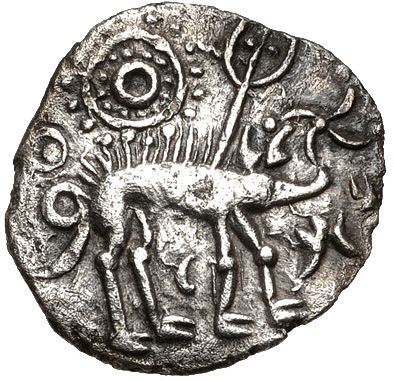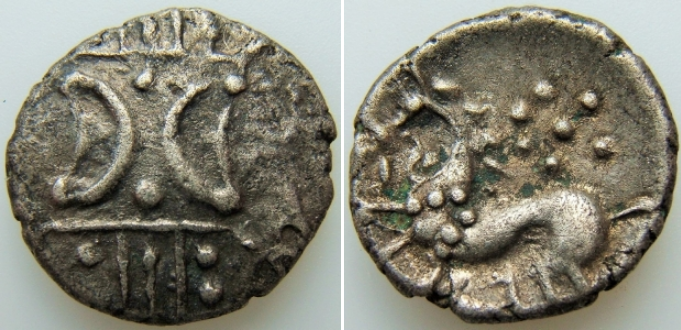The Iceni were a significant power in eastern Britain during Claudius' conquest of Britain in AD 43, in which they allied with Rome. They remained nominally independent under king Prasutagus until his death around AD 60. Roman encroachment after Prasutagus' death led his wife Boudica to launch a major revolt from 60–61. The Romans finally crushed the rebellion, and the Iceni were increasingly incorporated into the Roman province.
The Iceni began producing coins around 10 BC. Their coins were a distinctive adaptation of the Gallo-Belgic "face/horse" design, and in some early issues, most numerous near Norwich, the horse was replaced with a boar. Some coins are inscribed ECENI, making them the only coin-producing group to use their tribal name on coins.

(18).jpg)
Reverse: Stylised horse prancing right, with grain ear mane; [pelletal sun above], reversed S before, pellet triad, line of three pellets and [obscured monogram] below
Die Orientation: 9 H
Weight: 1.24 g
Before the Romans arrived Britain was shared by several Celtic tribes; the Iceni being centred on the Norfolk area (but also occupying surrounding parts of Suffolk and Cambridgeshire). The Iceni are probably best known as the tribe that, united with the Trinovantes (from the area north east of London), ran riot over Roman rule under their warrior queen Boudicca. This coin, whose Celtic name has never been discovered, is simply referred to as a ‘silver unit’. It is tiny at just 14mm diameter and weighing in at 1.24g. All of these coins weighed the same (1.25g); a standard which was maintained for over 100 years to an extremely small tolerance, an amazing techical achievement for the time. As with all Celtic coinage the design is somewhat abstract. On the obverse is an ornate pattern, resembling 2 C’s back to back across an ornate belt, with patterns around. This has been progressively derived from the hair & laurel head band of Apollo on Greek coins, whose face has since disappeared. The reverse shows a horse galloping towards the right, a dotted wheel above it’s back, and various dots around. The charioteer has disappeared, and what remains of the chariot is the wheel floating above. Some of the dots and symbols are not mere random decoration but part of a series of coded control marks, probably denoting the issuing mint and moneyer. The coins were struck on concave blanks which were only about two-thirds of the size of the dies, so the entire design is never seen on one specimen.

Reverse: Celticised horse left, 6 pellets on shoulder, floral pellets Sun above, ECEN (retrograde) below.
Die Orientation: 12 H
Weight: 1.09 g
